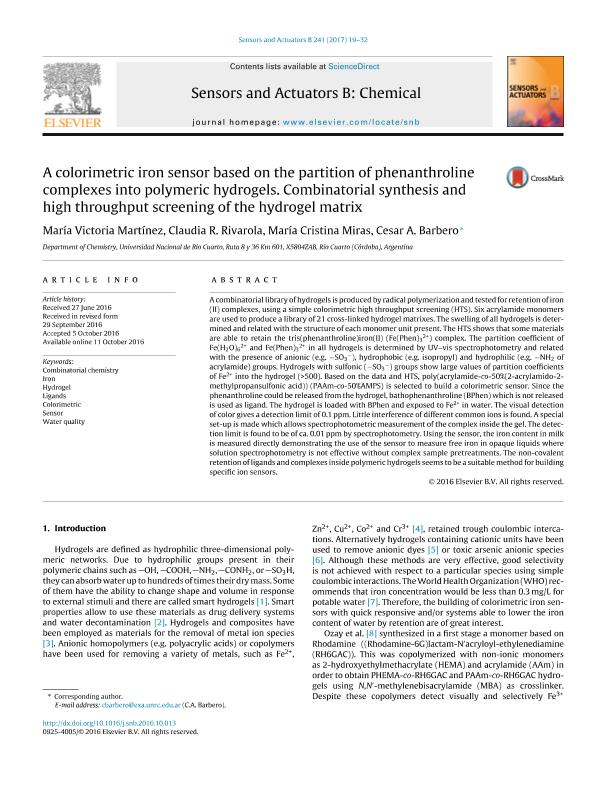Artículo
A colorimetric iron sensor based on the partition of phenanthroline complexes into polymeric hydrogels: Combinatorial synthesis and high throughput screening of the hydrogel matrix
Fecha de publicación:
03/2017
Editorial:
Elsevier Science Sa
Revista:
Sensors and Actuators B: Chemical
ISSN:
0925-4005
Idioma:
Inglés
Tipo de recurso:
Artículo publicado
Clasificación temática:
Resumen
A combinatorial library of hydrogels is produced by radical polymerization and tested for retention of iron (II) complexes, using a simple colorimetric high throughput screening (HTS). Six acrylamide monomers are used to produce a library of 21 cross-linked hydrogel matrixes. The swelling of all hydrogels is determined and related with the structure of each monomer unit present. The HTS shows that some materials are able to retain the tris(phenanthroline)iron(II) (Fe(Phen)32+) complex. The partition coefficient of Fe(H2O)62+ and Fe(Phen)32+ in all hydrogels is determined by UV–vis spectrophotometry and related with the presence of anionic (e.g. −SO3−), hydrophobic (e.g. isopropyl) and hydrophilic (e.g. −NH2 of acrylamide) groups. Hydrogels with sulfonic (−SO3−) groups show large values of partition coefficients of Fe2+ into the hydrogel (>500). Based on the data and HTS, poly(acrylamide-co-50%(2-acrylamido-2-methylpropansulfonic acid)) (PAAm-co-50%AMPS) is selected to build a colorimetric sensor. Since the phenanthroline could be released from the hydrogel, bathophenanthroline (BPhen) which is not released is used as ligand. The hydrogel is loaded with BPhen and exposed to Fe2+ in water. The visual detection of color gives a detection limit of 0.1 ppm. Little interference of different common ions is found. A special set-up is made which allows spectrophotometric measurement of the complex inside the gel. The detection limit is found to be of ca. 0.01 ppm by spectrophotometry. Using the sensor, the iron content in milk is measured directly demonstrating the use of the sensor to measure free iron in opaque liquids where solution spectrophotometry is not effective without complex sample pretreatments. The non-covalent retention of ligands and complexes inside polymeric hydrogels seems to be a suitable method for building specific ion sensors.
Palabras clave:
COLORIMETRIC
,
COMBINATORIAL CHEMISTRY
,
HYDROGEL
,
IRON
,
LIGANDS
,
SENSOR
,
WATER QUALITY
Archivos asociados
Licencia
Identificadores
Colecciones
Articulos(CCT - CORDOBA)
Articulos de CTRO.CIENTIFICO TECNOL.CONICET - CORDOBA
Articulos de CTRO.CIENTIFICO TECNOL.CONICET - CORDOBA
Citación
Martínez, María Victoria; Rivarola, Claudia Rosana; Miras, María Cristina; Barbero, César Alberto; A colorimetric iron sensor based on the partition of phenanthroline complexes into polymeric hydrogels: Combinatorial synthesis and high throughput screening of the hydrogel matrix; Elsevier Science Sa; Sensors and Actuators B: Chemical; 241; 3-2017; 19-32
Compartir
Altmétricas




